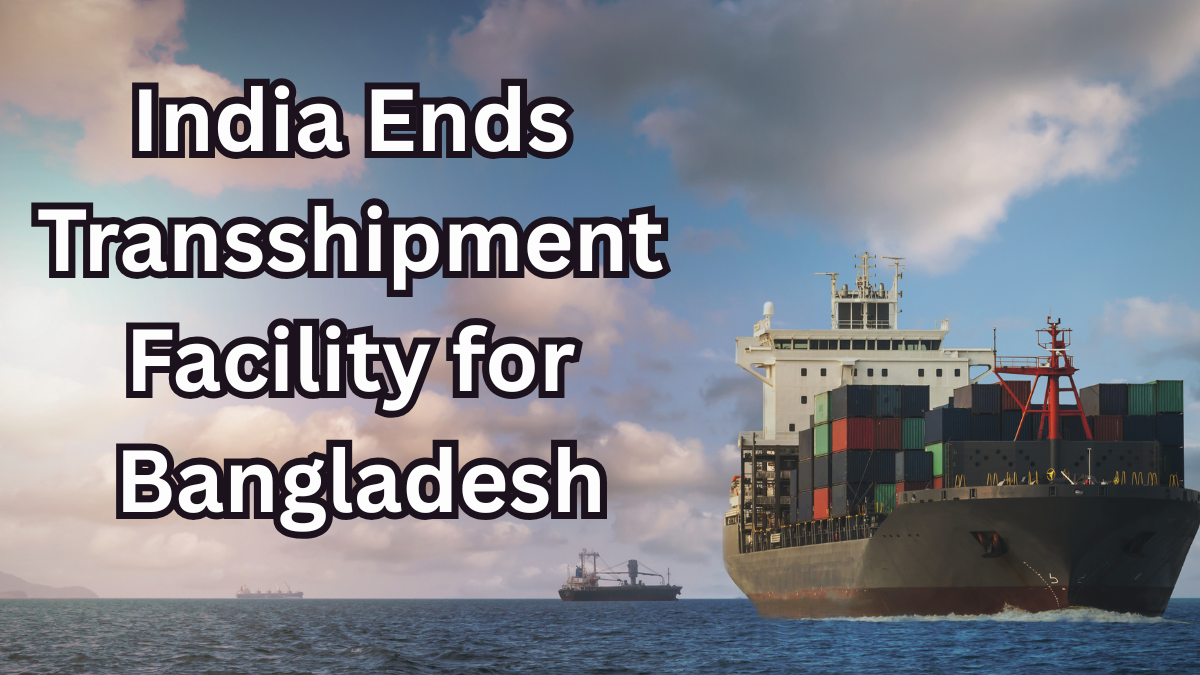In a significant move that could disrupt trade flows between Bangladesh and its neighboring countries, India has decided to terminate the transshipment facility for Bangladesh’s export cargo. This decision follows a series of developments related to Bangladesh’s recent strategic positioning in Northeast India and its engagement with China. The new move, issued by the Central Board of Indirect Taxes and Customs (CBIC), raises concerns about the impact on Bangladesh’s trade with countries like Bhutan, Nepal, and Myanmar.

Key Highlights of the Decision:
-
Termination of Transshipment Facility: India has rescinded the transshipment agreement, which had allowed Bangladesh to use Indian Land Customs Stations (LCSs) to transport cargo to third countries.
-
Circular Details: CBIC’s circular, dated April 8, 2025, cancels the earlier circular from June 2020, which had provided a streamlined route for Bangladesh’s exports.
-
Trade Disruptions Expected: Bangladesh’s trade with Bhutan, Nepal, and Myanmar is expected to be affected due to changes in the transit procedures through Indian infrastructure.
What Led to the Decision?
The move is reportedly tied to recent comments made by Bangladesh’s interim government’s Chief Adviser, Professor Muhammad Yunus, during his visit to China in late March 2025. Yunus suggested that Bangladesh could play a pivotal role in providing access to the ocean for landlocked Northeast India. His statement raised concerns in New Delhi, which sees such positioning as a potential strategic advantage for China in the region.
Yunus’s Remarks on Northeast India:
-
Strategic Importance: Yunus referred to Bangladesh as the “only guardian of the ocean” for Northeast India, which is a landlocked region.
-
Potential for Economic Expansion: He emphasized that Bangladesh could help facilitate the extension of the Chinese economy into the region, promoting trade and manufacturing partnerships.
This statement, particularly about China’s growing influence, has added fuel to the tension in the India-Bangladesh relationship.
Details of the New Circular and its Implications
The Global Trade Research Initiative (GTRI) has indicated that the new circular brings an immediate end to the transshipment arrangement. However, cargo that has already entered India under the previous system will still be allowed to exit as per the established procedures.
Impact on Trade:
-
The decision is expected to disrupt logistics for Bangladeshi exporters, especially for those using Indian infrastructure to reach Bhutan, Nepal, and Myanmar.
-
Increased Costs and Delays: The termination will likely result in higher transportation costs and longer transit times for Bangladeshi goods.
Key Trade Disruptions:
-
Logistical Bottlenecks: Without the previous arrangement, Bangladesh may face delays in moving goods to third-party countries.
-
Impact on Bhutan and Nepal: Both landlocked nations rely on India for transit access to Bangladesh, and the decision may restrict their trade options.
The Context of India-Bangladesh Relations
India has long supported Bangladesh’s trade by providing zero-tariff access to most Bangladeshi goods. However, the growing strategic partnership between Bangladesh and China, particularly concerning military and infrastructural investments, has raised concerns in New Delhi. The Chicken Neck area — a narrow land corridor connecting Northeast India with the rest of the country — remains a critical geopolitical issue.
What the Experts Are Saying
Ajay Srivastava, former trade officer and Head of GTRI, noted that while India has been a strong trade partner for Bangladesh, the recent developments could be linked to Bangladesh’s collaboration with China on projects near the strategic Chicken Neck region. Specifically, Bangladesh’s move to invite Chinese investments to revitalize an airbase in Lalmonirhat near the Siliguri Corridor has triggered concerns about China’s growing influence in the area.
India’s WTO Commitments
Despite the decision, WTO rules, specifically Article V of GATT 1994, mandate that WTO members must allow freedom of transit for goods, especially for landlocked countries. India’s new policy could be seen as a violation of these rules, particularly in light of the WTO Trade Facilitation Agreement (TFA), which encourages transparency, reduced inspections, and regional cooperation.
FAQs
1. Why did India end the transshipment facility for Bangladesh?
India ended the transshipment facility in response to growing concerns about Bangladesh’s increasing strategic collaboration with China, particularly regarding its role in Northeast India and the region’s infrastructure.
2. Which countries will be most affected by this change?
Bangladesh’s exports to Bhutan, Nepal, and Myanmar will be directly impacted by this decision, as these countries rely on Indian transit routes for trade with Bangladesh.
3. Will goods that are already in transit be affected?
No, goods that have already entered India under the previous transshipment system will be allowed to exit according to the existing procedures.
4. How does this decision impact India’s trade commitments under the WTO?
The decision may raise concerns regarding India’s adherence to WTO commitments, particularly under Article V of GATT 1994, which mandates free and unrestricted transit for goods to and from landlocked countries.
Conclusion
India’s decision to end the transshipment facility for Bangladesh is a significant development with the potential to disrupt regional trade dynamics. The shift in India-Bangladesh relations and the growing involvement of China in the region adds a complex layer to the situation. The full impact of this move will unfold over the coming months, especially as affected countries, including Nepal and Bhutan, assess the new logistical challenges they face.
Click here to learn more
